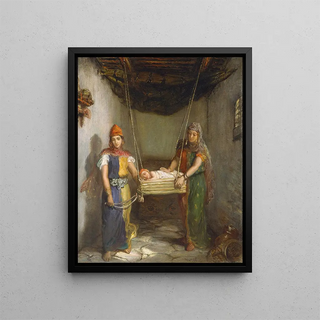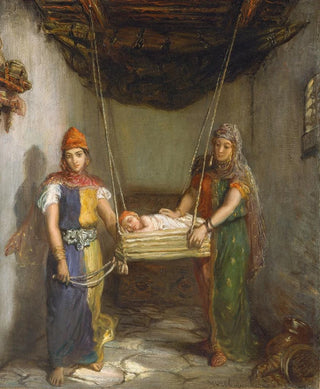Art print | Scene in the Jewish quarter of Constantine - Théodore Chassériau


View from behind

Frame (optional)
The artwork "Scene in the Jewish quarter of Constantine" by Théodore Chassériau is a piece that transports the viewer into a universe rich in colors and emotions. Painted in the mid-19th century, this work bears witness to an era when Orientalism fascinated European artists, attracted by the lights and shadows of distant cultures. Chassériau, through this vibrant scene, invites us to discover the daily life of a Jewish quarter in Algeria, thus revealing a reality that is both intimate and universal. The art print of this work not only allows appreciation of the finesse of the brushwork and the depth of colors but also immerses you in the unique atmosphere that the artist was able to capture.
Style and uniqueness of the work
Chassériau's style is characterized by a remarkable mastery of color and light, which is vividly displayed in "Scene in the Jewish quarter of Constantine." The composition is both dynamic and harmonious, with each character carefully placed to create a visual narrative. The shades of blue and earth tones, typical of the Orient, intertwine to give life to an animated scene where human warmth and authenticity of exchanges are perceived. The delicacy of faces and gestures demonstrates a particular attention to detail, inviting the viewer to come closer and discover the intensity of emotions. Chassériau manages to combine poignant realism with a certain idealization, making his work both accessible and deeply touching.
The artist and his influence
Théodore Chassériau, born in 1819 and died in 1856, is often considered a precursor to the Impressionist movement, although he was heavily influenced by Romanticism and Orientalism. His artistic journey was marked by encounters with masters such as Delacroix, whose sense of color and passion for exotic subjects he admired. Chassériau developed a distinctive style, blending academic tradition with innovation. His work had a significant impact on his contemporaries and paved the way for new artistic explorations. By choosing to depict scenes

Matte finish

View from behind

Frame (optional)
The artwork "Scene in the Jewish quarter of Constantine" by Théodore Chassériau is a piece that transports the viewer into a universe rich in colors and emotions. Painted in the mid-19th century, this work bears witness to an era when Orientalism fascinated European artists, attracted by the lights and shadows of distant cultures. Chassériau, through this vibrant scene, invites us to discover the daily life of a Jewish quarter in Algeria, thus revealing a reality that is both intimate and universal. The art print of this work not only allows appreciation of the finesse of the brushwork and the depth of colors but also immerses you in the unique atmosphere that the artist was able to capture.
Style and uniqueness of the work
Chassériau's style is characterized by a remarkable mastery of color and light, which is vividly displayed in "Scene in the Jewish quarter of Constantine." The composition is both dynamic and harmonious, with each character carefully placed to create a visual narrative. The shades of blue and earth tones, typical of the Orient, intertwine to give life to an animated scene where human warmth and authenticity of exchanges are perceived. The delicacy of faces and gestures demonstrates a particular attention to detail, inviting the viewer to come closer and discover the intensity of emotions. Chassériau manages to combine poignant realism with a certain idealization, making his work both accessible and deeply touching.
The artist and his influence
Théodore Chassériau, born in 1819 and died in 1856, is often considered a precursor to the Impressionist movement, although he was heavily influenced by Romanticism and Orientalism. His artistic journey was marked by encounters with masters such as Delacroix, whose sense of color and passion for exotic subjects he admired. Chassériau developed a distinctive style, blending academic tradition with innovation. His work had a significant impact on his contemporaries and paved the way for new artistic explorations. By choosing to depict scenes






